Culture Watch
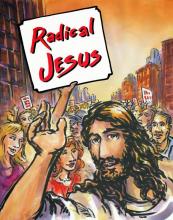
THE GRAPHIC NOVEL Radical Jesus, edited by Paul Buhle, has three distinct sections offering different expressions of Jesus’ life and social message. The brevity of the graphic novel medium allows the writers to construct a clear and distinct message in a moving art form.
Part one, “Radical Gospel,” illustrated by Sabrina Jones, uses biblical quotes to construct a visual story that connects the words of Jesus to modern situations. The black and white ink styling is simple yet profound.
While Jesus and his disciples are portrayed as first century Jews, the people Jesus interacts with and tells parables about are all in modern dress. This puts Jesus in an accessible conversation not only with his disciples, but also with the reader. In a collection of Jesus’ sayings from the Sermon on the Mount, the art drives home the emotional impact of his words.
Jones does not shy away from the radical implications of Jesus’ message. My favorite of her modern interpretations is an image of the destruction wreaked by the 9/11 attacks, contrasted with Jesus’ reference to the temple in Jerusalem, where he exclaims, “The day will come when there isn’t one stone left on top of another that is not thrown down.”
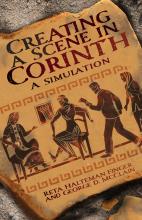
ONE YEAR MY small group decided to have each member choose a person named or alluded to in the gospels to “follow” during Lent. We researched our people and the customs of that time and reflected individually and collectively on their encounters with Jesus. Then we hosted a community meal for family and friends on the night before Easter. Each member of our group came in character as the person we’d studied and tried to recreate the mood of that frightening, confusing, grief-filled night for followers of Jesus after his death and before his resurrection. After the meal, each of us presented a monologue that tried to project what our person might have been thinking and experiencing at that time.
The attempt to immerse mind, soul, and body into scriptures that I had listened to for much of my life (but perhaps hadn’t really heard) was a transformative experience: It burned away long-held assumptions and revealed new facets of chapter and verse.
The book Creating a Scene in Corinth: A Simulation, by Sojourners contributing editor Reta Halteman Finger and George D. McClain, provides a useful and fun toolbox for small groups, Sunday schools, religion classes, and even imaginative individuals who want their own full-immersion experience of scripture and biblical scholarship. It invites readers to a deeper understanding of the apostle Paul’s letter to the church in Corinth by using role play to “become” members of the different factions of that community as they hear Paul’s words read for the first time. The authors assert that “as we more clearly experience what Paul meant in the first century, we can better understand what his writings mean in our 21st century context.”
THE STILL, ATTENTIVE, affectionate, at times lamenting, always sagacious, well-defined, occasional poems in This Day, Wendell Berry’s most recent collection, are a magnificent gift to American letters.
For nearly 35 years Berry has kept the Sabbath holy. His practice is either unorthodox or so deeply orthodox that professional religionists may not recognize it. On Sundays Berry walks his Kentucky “home place,” the roughly 125 acres of bottom land in the region his family has farmed for more than 200 years. From the seventh-day silence, solitude, and natural world, Berry has crafted his Sabbath poems.
“Occasional poems” commemorate public events, but here Berry lays quiet markers to remember personal days in the life of one man. He writes in the preface: “though I am happy to think that poetry may be reclaiming its public life, I am equally happy to insist that poetry also has a private life that is more important to it and more necessary to us.”

ONE OF THE paradoxes of writing about film is the application of one form of language to interpret another. The medium we’re discussing here is visual, and despite the relevance of the word “poetic” to the great works of cinema, to interact with the movies means, as writer-director John Sayles says, to “think in pictures.” In an age with multiple ways to consume films, and the pressure to respond with the immediacy of social media, to think deeply about movies is a countercultural act.
I noticed this again after being given a record player a few weeks ago. I’ve listened to Van Morrison’s Astral Weeks more than pretty much any other album over the past 20 years and now on the vinyl recording I can actually hear instruments I’d never noticed before. I can’t deny the superiority of the medium, at least in terms of what we might call “musical richness.” But digital transmission makes the sound crisper and more available.
There’s a parallel paradox with cinema, in that the experience of watching films has both diminished and expanded over most of our lifetimes. There are more portals than ever (you can watch Yasujiro Ozu’s Tokyo Story or Alfred Hitchcock’s Vertigo on your phone, for goodness’ sake). Yet the opportunity to see films in optimal settings (decent projection, focused audience, without 25 minutes of commercials for soda mingling with threats of prosecution directed at the people who have paid to see the film by the industrial complex that depends on them) doesn’t come often for most of us. Without conscious resistance, the flattened culture of entertainment globalization is going to continue to dominate.
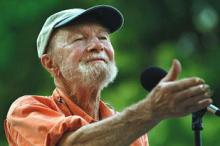
WHEN I MOVED out of my Sojourners magazine office in 1988, I took with me two signed review copies of books. One was Roll the Union On: A Pictorial History of the Southern Tenant Farmers’ Union. It was inscribed to me personally by H.L. Mitchell, a founder of the STFU, so I felt entitled to keep it.
The other book bore no inscription, just a simple black ink signature above the Simon & Schuster logo. It was called Carry It On! A History in Song and Picture of America’s Working Men and Women, and the co-author who signed it was Pete Seeger. I’m looking at that signature now, as I write this on the day Seeger died.
I told myself that I kept that book because I thought it might come in handy. After all, it had 11 translations of “L’Internationale” and all the words to “Solidarity Forever.” But really I kept it for the signature. I liked the idea of having something that I knew had come from the hand of someone who had ridden the rails with Woody Guthrie. Seeger was our living connection to the culture of the 1930s when, for a moment, radical dreams about a country owned and operated by its ordinary citizens seemed almost ready for prime time.
Of course, that moment passed, and those dreams were shattered by the Red Scare and the Cold War that followed. But Seeger came out on the other side with his integrity and ideals intact. Despite being honored by the last two Democratic presidents, he never renounced his radical vision of what America could be. Seeger left the Communist Party in the early 1950s and frankly acknowledged that he should have done so sooner, but he never stopped calling himself a “small c” communist. In 1994, he told The Washington Post, “Our ancestors were all socialists: You killed a deer and maybe you got the best cut, but you wouldn’t let it rot, you shared it.” Still, he was a pragmatic radical, who added that socialists should recognize that “every society has a post office and none of them is efficient. No post office anywhere invented Federal Express.”
WHEN I MOVED out of my Sojourners magazine office in 1988, I took with me two signed review copies of books. One was Roll the Union On: A Pictorial History of the Southern Tenant Farmers’ Union. It was inscribed to me personally by H.L. Mitchell, a founder of the STFU, so I felt entitled to keep it.
The other book bore no inscription, just a simple black ink signature above the Simon & Schuster logo. It was called Carry It On! A History in Song and Picture of America’s Working Men and Women, and the co-author who signed it was Pete Seeger. I’m looking at that signature now, as I write this on the day Seeger died.
I told myself that I kept that book because I thought it might come in handy. After all, it had 11 translations of “L’Internationale” and all the words to “Solidarity Forever.” But really I kept it for the signature. I liked the idea of having something that I knew had come from the hand of someone who had ridden the rails with Woody Guthrie. Seeger was our living connection to the culture of the 1930s when, for a moment, radical dreams about a country owned and operated by its ordinary citizens seemed almost ready for prime time.
Of course, that moment passed, and those dreams were shattered by the Red Scare and the Cold War that followed. But Seeger came out on the other side with his integrity and ideals intact. Despite being honored by the last two Democratic presidents, he never renounced his radical vision of what America could be. Seeger left the Communist Party in the early 1950s and frankly acknowledged that he should have done so sooner, but he never stopped calling himself a “small c” communist. In 1994, he told The Washington Post, “Our ancestors were all socialists: You killed a deer and maybe you got the best cut, but you wouldn’t let it rot, you shared it.” Still, he was a pragmatic radical, who added that socialists should recognize that “every society has a post office and none of them is efficient. No post office anywhere invented Federal Express.”

ONE RECENT WINTER day, Nora Howell stepped out of her house in the Sandtown neighborhood of Baltimore and took a walk down the street. People in the predominantly black community did double takes as this white woman promenaded past them in a sundress made of saltine and oyster crackers. Some stared in disbelief. One man doubled over laughing. In the corner coffee shop, one of the regulars warned Howell not to walk by any homeless people because they might just eat her up.
Later Howell, a community artist and director of the neighborhood Jubilee Arts program, set the video footage taken during her walk to Mister Rogers’ classic refrain, “Won’t You Be My Neighbor?” The piece, which emerged out of Howell’s ponderings on what it means to be white living in a black neighborhood, became another part of her answer to a call: to use art to address systemic racism and bring about the kingdom of God.
From Race Riots to White Suburbia and Beyond
In 2001, Howell was an eighth grader living in a biracial community in urban Cincinnati. When race riots erupted after a young black man was shot fatally by a white police officer (sound familiar?), her family took to the streets on a prayer walk through the riots. Howell remembers being shocked and terrified, thinking, “Why do we still have race riots? Cincinnati is so far behind the times.”
In the aftermath, Howell talked with peers at school on the reality of racial tensions and observed with curiosity how white and black churches throughout the city responded. She realized race riots weren’t just a relic of the ’60s. “When you lived in a place where different racial groups interacted daily, [racial tensions] could no longer be denied or ignored,” she said.
Yet when Howell moved to suburban Chicago to attend Wheaton College, conversations on race were largely absent. “I found that very odd,” she said. She got involved in a campus group to promote awareness of racial injustice.

Bio: Carol Roth [Choctaw] is staff leader for Native Mennonite Ministries, a group that does liaison work between Native Mennonites and the broader Mennonite church. www.mennoniteusa.org/about/structure/related/
1. What are you most passionate about in your vocational role?
I’m passionate about working with the Native Mennonite people and helping them find a place in the Mennonite church. Unfortunately, some of the Native churches aren’t close to the Mennonite conferences, so you have to drive 800 miles to be connected to a conference, especially when you live on a reservation without internet or telephone. So my role is to connect the conference ministers and the conference with the Native churches and get them involved.
2. How did you come to straddle the Mennonite and Choctaw traditions?
When my twin sister and I were born [on a Choctaw reservation in Mississippi], my mom felt like she couldn’t give adequate care to two newborns. It happened that there were Mennonite missionaries who had moved nearby to help with the Choctaw group, and my parents asked if they could care for us for the winter. My parents realized how well they were taking care of us, so they asked if they could continue to care for us. My parents didn’t want them to adopt us, because they wanted us to keep our culture. So we grew up with the Mennonite missionaries, and then pretty much for all our lives attended one of the Choctaw churches.
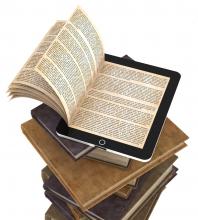
I’VE BEEN thinking a lot lately about technological obsolescence. This isn’t because I’m a classroom teacher and professional writer—two occupations widely expected to meet the fate of John Henry. My musings have mainly been prompted by the hours I just spent weeding through my family’s extensive collection of cassette tapes. From 1992 to about 2005, my wife, Polly, and I made a sizeable investment in that doomed medium, mostly in the form of children’s audiobooks and home-school educational programs that our kids (now ages 14 to 21) have outgrown. We still have three functioning cassette players in our house, but then we still have a 22-year-old tube television, too. I don’t expect that anyone who has young children today would be willing to take on our collection of cassettes. Even Goodwill may refuse them.
Some things, like the cassette tape, deserve to become obsolete. They were always an inferior product. But, all the logic of the market economy to the contrary, newer is not always, or even usually, better.
That’s why it’s been heartening to witness, in the past year or so, the beginning of a small backlash against our forced march toward a future that is all-digital, all the time. The first sign of a revolt was the return of the vinyl record. Of course, I held on to my vinyl through all the transitions of the past 30 years, and we’ve always had a functioning turntable in the house. But now it is my 21-year-old son who actually buys vinyl. Of course, my son also has an iPod and does most of his listening through headphones, like the rest of his peers. But he and thousands of other young music buffs have learned that vinyl delivers a better sound than any of the digital formats currently on the consumer market.

Faith and Reform
Writer and social reform Harriet Beecher Stowe’s controversial 1852 novel Uncle Tom’s Cabin brought many people to the anti-slavery movement. In Harriet Beecher Stowe: A Spiritual Life, biographer Nancy Koester illuminates the shifting role and expression of faith in Stowe’s personal and public life and work. Wm. B. Eerdmans
Falling into Love
A few years ago a young man named Rocky Braat left Pittsburgh to wander India; he’s ended up working for years in an orphanage for HIV-positive children there. His friend, filmmaker Steve Hoover, went to explore why. The result is a Sundance-award-winning documentary, Blood Brother. www.bloodbrotherfilm.com
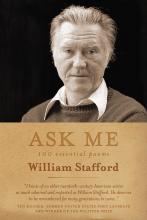
Miles of yellow wheat bend; their leaves / rustle away and wait for the sun and wind.
—From “A Farewell, Age Ten”
We wondered what our walk should mean, / taking that un-march quietly; / the sun stared at our signs—"Thou shalt not kill.”
—From “Peace Walk”
WILLIAM STAFFORD was a poet of the land and a conscience that fanned out over the land. Born in Hutchinson, Kan., 100 years ago—on Jan. 17, 1914—it was perhaps his early intimacy with space and sky that opened him to the mystery of human frailty.
At age 6, he saw two black students at his school being taunted by whites. He stood with them.
Another mystery: He who personifies the term national poet is largely unknown in his nation. Four new books (in his 79 years, Stafford published more than 50 books) published to coincide with his centennial might help redress this situation. Ask Me (Graywolf Press), from which the above excerpts are taken, brings to readers 100 “essential” Stafford poems dealing with his pacifism, his family, Native Americans, and the landscapes of his native Kansas and his adopted Oregon, where many centenary events are scheduled to take place.

INSIDE LLEWYN DAVIS, the new Coen brothers film, is the mournful tale of a folk musician too dedicated to his art to make money or to accept love when it’s offered him. It has gorgeous music, performances that are like watching characters step off the pages of a Joseph Mitchell New Yorker story, and language that is exquisite, but not so much that we don’t believe it. A common response to Inside Llewyn Davis is that it’s a pessimistic film, with characters so self-centered and worn down by money and the lack thereof that they cumulatively produce a world of no hope.
Many assert that the Coen brothers have pitched their tent as the anchor tenants of cinematic melancholia—Fargo’s bleak focus is a family utterly destroyed by financial pressures and the inability to know where or how to ask for help; Barton Fink’s eponymous protagonist finds his dream writing contract ends up a descent into hell; and The Man Who Wasn’t There is finally executed because he doesn’t see the point in defending himself. Llewyn Davis is an impetuous man in a fickle industry, too out of touch with his own humanity to want to see his own child, and he is beaten up for heckling a fellow musician. And so people come out of this film depressed. To which my minority response is simple: Look closer. Inside Llewyn Davis is full of life and second chances and, yes, hope for artists. Davis has friends who care, and there are people who get what he does. Who cares if the world isn’t listening? That was never a measure of great art anyway.
AS AN EVANGELICAL pastor of a multiethnic church in New York City, I often find myself at the intersection of lively discussions about race. These conversations almost inevitably lead to a familiar question: What does the church do now? Maybe stated another way, “How do we work toward the dream of the beloved community?” This is why I find Edward Gilbreath’s Birmingham Revolution: Martin Luther King Jr.’s Epic Challenge to the Church to be a timely and necessary read.
While many books have been written on Dr. King and civil rights, Birmingham Revolution places King’s faith at the foreground of the writing. This is an important distinctive as King has often been co-opted, by conservative and liberal agendas alike. Yet history cannot deny that prayerful action, and a gospel that took seriously the social dimensions of human life, were at the very heart of King’s theology.
Birmingham Revolution hones in on the year 1963—a time when the Southern Christian Leadership Conference took the civil rights efforts into the bowels of structural racism. Brown vs. Board of Education had provided an important Supreme Court victory in 1954, but many forms of local resistance to desegregation prevailed in the South.
To compound the drama, many advocates in Alabama, both black and white, believed further progress should happen through legal means. They had a misplaced confidence that local structures would uphold federal law, despite the continued presence of the KKK and other such groups. Gilbreath explains Birmingham’s defining moment not only in confronting segregation, but also in challenging the subtler, unwittingly complicit voice of the moderate.
IN HER LATEST book, Sara Miles—author of the spiritual memoirs Take This Bread and Jesus Freak—goes where traditional and liturgical churches don’t regularly go: into the streets to push the boundaries of public worship. City of God chronicles a day in the life in San Francisco’s Mission District, on one Ash Wednesday when Miles and others from St. Gregory of Nyssa Episcopal Church offer “Ashes to Go,” a growing national movement within the Episcopal Church to perform the imposition of ashes outside the church walls on the first day of Lent.
Ash Wednesday works on the street because it has a broad ability to speak to people with “different beliefs about God and very different relationships to the church.” Even so, carrying the observance away from the altar has generated critics. Some liturgists have wondered if, without a proper church context, “the ashes become a meaningless affirmation of our earthly life,” or whether regular folks on the street can really appreciate the profundity of the human condition and mortality without the church to explain it to them. Trusting that people on the street will “get it,” Miles embarked on a day of crossing the traditional borders of worship space to smudge foreheads in McDonald’s, taquerias, hair salons, and botanicas.
Miles finds that traditional observance of liturgies such as Ash Wednesday helps reclaim the public language of sin and repentance in a progressive way. This kind of re-evaluation of sin in common life led her to realize how she’s also fallen short of the call to solidarity and deep communion with the city. “I aspired to be the kind of neighbor who knew everyone,” she writes, “I yearned to be in real relationship.” But her admittedly self-satisfied sense of fellowship didn’t match up to her interactions. She hadn’t even bothered to learn the last name of a young Latino activist on her block and confesses, “I prayed for my neighbors, but not so much with them, and it made me uncomfortable.”
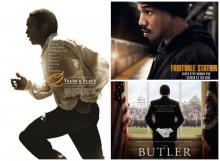
“CINEMA IS a matter of what’s in the frame and what’s out.” With this, Martin Scorsese, one of the greatest living U.S. directors, gives us a simple window to understand the power of cinema. What is in the frame is a choice by the filmmaker, and what is not highlighted is also a choice.
People of color, literally and metaphorically, have struggled to be included in the frame and fought to move from the background to the foreground of the cinematic imagination.
The U.S. cinema, historically, has been the vanguard of stereotypes and the enforcer of our racialized imagination. Our view of women, people of color, and ethnicities define and are expanded by the power of cinema.
D.W. Griffith’s 1915 silent film The Birth of a Nation was a revisionist history of the Civil War and Reconstruction that defined the Ku Klux Klan as the hero of the story and used white actors in blackface to frame black people as a threat to white society. This film, while not seen by the majority of filmgoers, set into motion the racial constructs we now view as normative. Black men, for example, have often been viewed in cinematic history as ethically dubious, highly sexualized, violent, or childlike comic characters.
These stereotypes created by the filmmaker’s imagination became, in the minds of many in the U.S., a historical fact. Cinema helped reinforce myths and arbitrary prejudices not based on cultural differences but created to protect economic interests of white Southerners who feared black labor.
SHORTLY AFTER his 1983 appointment as archbishop of San Salvador during the Salvadoran civil war, Arturo Rivera y Damas traveled to the United States. Rivera succeeded Archbishop Óscar Romero, who was martyred for his outspoken condemnation of the war. I asked a Maryknoll sister—who lost three community members, killed by the Salvadoran death squads—to assess Rivera’s comments to the U.S. media. “He does not have the gift of martyrdom,” she said.
That comment gives perspective to the efforts of nonviolent peace activists in the U.S., many of whom have risked their freedom, usually for short stints, as a consequence of civil disobedience. In Crossing the Line: Nonviolent Resisters Speak Out for Peace, Rosalie G. Riegle chronicles the action-to-court-to-jail-and-prison journeys of some of the last century’s most committed pacifists. While a few told harrowing stories, for the vast majority the consequences fell far short of martyrdom. This is not to belittle their efforts, but rather to beg the question: Why do so few Christians resist the violence and war-making of the U.S. government?
Riegle’s well-done compilation of 65 oral histories might prompt more people to step into the fray. To date, hundreds of U.S. pacifists have served hundreds of years, mostly in federal prison, for crossing lines, burning draft cards and draft files, and hammering on the weapons of war. At press time, three Catholic pacifists known as the Transform Now Plowshares—Sister Megan Rice, Greg Boertje-Obed (interviewed in Riegle’s book), and Michael Walli—await a January sentencing for federal felony charges stemming from cutting fences and hammering at the Y-12 National Security Complex in Oak Ridge, Tenn.

THE WOMEN IN Talking Taboo: American Christian Women Get Frank About Faith aren’t just frank. They are courageous, clever, and wildly passionate.
This anthology, edited by Erin S. Lane and Enuma C. Okoro, asks 40 women under 40 to respond to the question, “What taboos remain in the church at the intersection of faith and gender?” The result is a collection of stories by women of faith (Baptist, Presbyterian, Mennonite, Catholic, Unitarian Universalist, and more) in a variety of roles (pastor, mother, writer, teacher, student, and more).
The women share times they have felt shamed, alienated, discouraged, or alone as women seeking a home in the church. From addressing domestic violence to lust to pregnancy to the role of a woman pastor’s body, the stories are raw in the way first-person narrative calls upon honesty and vulnerability to trump perfect prose or style.
Anthologies often stick to one structural extreme: Either they are rigid and theme-driven, or loose and nomadic. Talking Taboo follows the latter. Lane’s introduction promises no arc of narrative, no solid take-away message. The stories are here, she writes, because women are agreeing to “speak for ourselves.”
I’VE RECENTLY spent time researching the vision of the U.S. through the lens of one film for every state, following the intuition that, as most movies are set in Southern California or New York (and there’s a lot more America where those didn’t come from), we need to examine Fight Club and On the Waterfront, Brokeback Mountain and Nashville no less than The Wizard of Oz and Gone with the Wind to begin to capture the American dream life. It seems obvious, but it’s often dismissed: Contrasts between the states are mighty and rich. A Wyoming plain and a Sonoma vineyard, Hoboken and Harlem and Hot Springs, the Florida Keys and the Swannanoa Valley are all magnificent intersections of dreams and mistakes, which in honest art allows them to be places where the past can be faced.
And on that note, here’s my list of the 10 best U.S. films released in 2013:
The new Criterion Blu-ray John Cassavetes box set includes The Killing of a Chinese Bookie, the best entry to his work: A grimy thriller about one man trying to make art against the odds.
Jeff Bridges and Rosie Perez show us something more of how to be human in Fearless (newly available on Blu-ray), about a man who needs to die before he can live (and love).
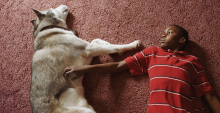
2013 WAS ANOTHER year when the future arrived. We’ve been having a lot of those lately. First there was 2010. According to the Project for Excellence in Journalism, that year more Americans got their news online than from reading a newspaper. Next, 2011 was the year when the internet started replacing not just the local bookstore, but books themselves. That’s when Amazon made more money from e-books than from real ones. The same thing happened in 2012, when revenue from music downloads surpassed that from the sale of recorded discs.
The newest future dawned last year when the American Academy of Television Arts and Sciences officially recognized that the internet was replacing TV. They didn’t say that, of course. The Academy just said that online streaming series, such as Netflix’s House of Cards andArrested Development, were eligible for Emmy Awards. For a little perspective here, the Emmys were once only for broadcast TV—the stuff you can get from a roof antenna. Cable productions became eligible in 1988, and last year not a single broadcast production was even nominated for the best drama award.
In the first year of internet eligibility, David Fincher won the best director Emmy for House of Cards. In case anyone still thinks that web TV is for has-beens and wannabes, in 2011 Fincher was nominated for the best director Oscar for The Social Network. Last fall, Doonesbury creator Garry Trudeau produced a series (Alpha House) for streaming on Amazon. For the record, Trudeau’s last television venture was Lucas Tanner for HBO, in 1988.
Hagar’s Story
Sisters in the Wilderness: The Challenge of Womanist God-Talk, by Delores S. Williams, now professor emerita of theology and culture at Union Theological Seminary, is a landmark in womanist thought. The recently released 20th anniversary edition has a new foreword by Katie G. Cannon. Orbis
Moving Music
Jon Batiste and his band, Stay Human, have played on the New York subway and in other public spaces in free-ranging, mobile performances they call “love riots.” Their album Social Music offers that same positive spirit and a fresh take on jazz. Razor & Tie

MY MOTHER-IN-LAW wears a bikini. She is 70 years old and decades of gravity have done their work. But she wears a bikini nonetheless, with a devil-may-care nonchalance to what others her age are more inclined to cover in sarongs, ruffles, and cruise-wear.
She’s my hero.
Her okay-ness with her body has a twofold source. First, she’s Finnish. Do you know any Finns? Untouched by the Puritan prudishness that is historically English and North American, they share a continental European lack of modesty concerning the body, but to the extreme. While other Europeans are going topless on the warm and sunny beaches of the French Riviera, the Finns are flinging themselves buck naked from their saunas into the snow. There’s a reason to take off your shirt in the south of France—it’s hot! But why subject your private parts to the crunch and scrape of ice in the dead of winter? I don’t have an answer, even though I live with a Finn who regularly goes in for the naked sauna/snow frolicking thing. But, the point is, Finns are profoundly okay with their bodies.
How does this relate to Christian theology? My mother-in-law is also a devout Christian, and I think her embrace of the bikini as her swimwear of choice goes beyond her Finnish heritage to her biblical understanding of creation. She understands that when it says in the Bible that Adam was formed out of the dirt (adama in Hebrew), that she too is a human formed out of humus and that humus is good. She actually believes that when it says, “God saw all that he had made and it was good,” that means her body as well. It also means mountains and trees and iguanas, but one’s body is a great place to start.